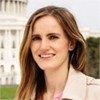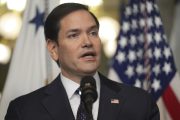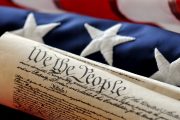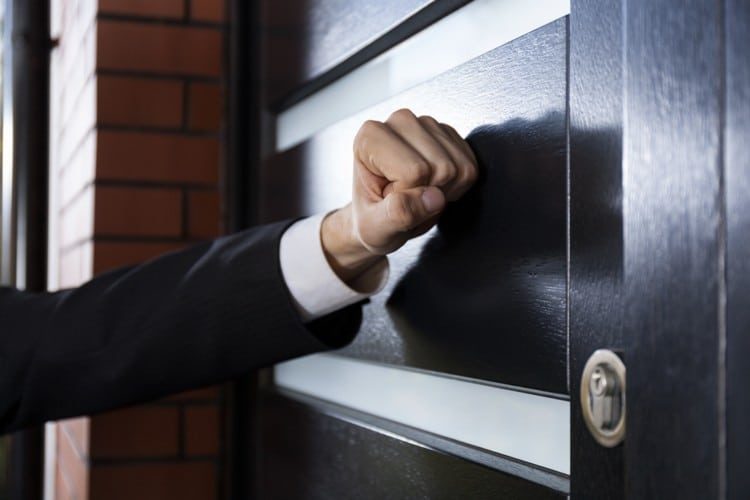
Fresh from missing his Fourth of July goal of having 70 percent of the adult population with at least one shot of the COVID-19 vaccine, President Joe Biden plans to step up the effort to get more Americans inoculated by sending public health workers “door-to-door.”
Amid the administration’s raising concerns of a surge of the “Delta” variant of the virus, President Biden pitched his plan to boost the vaccinated population during remarks he made on Tuesday.
“Now we need to go community by community, neighborhood by neighborhood and oftentimes door-to-door — literally knocking on doors — to get help to the remaining people protected from the virus,” Biden said.
He went on to claim that “equity and equality” remain the central ideas of the government’s responsibility to ensure that the communities “hit hardest” by the virus “have the information and the access to get vaccinated.” The president also stated that the administration will be shifting an effort from the mass vaccination sites to opening more local, smaller vaccination access points, including 42,000 local pharmacies that would be “more convenient” to go to for a jab. That way, one could get a vaccine just as easily as they would a toothpaste, Biden said.
Second, the vaccines will be provided to people by their regular healthcare providers, “folks they know and trust the most.” Same goes for the children’s doctors. They will be providing vaccines when a child gets a back-to-school checkup.
Also, the administration plans to work closely with businesses so they could ensure the vaccination sites are available at work, too. One could even get paid time off to get a jab, the president said.
Finally, Biden announced that since the administration is “soon” anticipating seeing outbreaks of the infection among the unvaccinated, and is setting up the “COVID-19 surge response teams,” noting that they would be made up of “experts” from a number of federal agencies, including FEMA and the CDC. They will help states to “prevent, detect, and respond to the spread of the Delta variant among unvaccinated people in communities with low vaccination rates,” the president said.
White House Press Secretary Jen Psaki also referred to the “door-to-door” effort while listing the five objectives of Biden’s COVID response earlier in the day at Tuesday’s briefing, citing “targeted community door-to-door outreach” to “get remaining Americans vaccinated by ensuring that they have the information they need on how both safe and accessible the vaccine is.”
The announcement of government “experts” going door-to-door to encourage people to get a jab raises lots of questions the journalists, as usual, had no chance to ask the president. Will the government representatives go to the communities that are “hit hardest” by the infection or those with the low vaccination rate? For example, 40 percent of Alabama residents have received at least one dose, and 32 percent are fully vaccinated, which is one of the lowest rates in the nation. But Alabama has a low infection rate, too.
Also, since knocking on every single door may require lots of resources (not that the government cares much about any wasteful programs), it is reasonable to ask: Does the government have a national database of the vaccinated/unvaccinated Americans to plan the “targeted outreach?”
If there is a national vaccination database, where is this information stored, who oversees it, and how is it protected, given the flurry of cyberattacks on the U.S. entities? In April, Psaki assured that there “will be no federal vaccinations database,” and that they wouldn’t support a system requiring Americans to carry any COVID-19 vaccination credentials amid privacy concerns. Yet it seems like there is such a database.
Another head-scratcher: Why does the administration assume that the people who are “vaccine hesitant” would embrace the government intruders preaching them on an importance of getting inoculated? One may have legitimate health conditions that exclude them from receiving a shot, for example. Or one might have, after careful consideration, decided that the risks of taking the vaccine outweigh the purported benefits. But there is more.
A recent Kaiser Family Foundation poll found that a hefty part of those unvaccinated are Republican (49 percent versus 29 percent Democrats), as opposed to 31 percent of vaccinated respondents who identified as Republicans and 59 percent Democrats. Also, there are discrepancies between unvaccinated respondents who said they would “definitely not” get the vaccine and those who just plan to “wait and see.” The “definitely not” group is overwhelmingly more white (70 percent of respondents), Republican (67 percent) and concentrated in the 30-49 age group (48 percent). At the same time, Gallup found that 78 percent of those Americans who have chosen to skip the COVID-19 vaccine are unlikely to ever change their mind. Biden still wants to try, sending the friendly public workers to talk about the errors of the “conspiracy theorists” and anti-vaccine “misinformation.”
The correlation between the political preferences and vaccination rate is distinct, as shown in the table below.
Click here to enlarge the image.
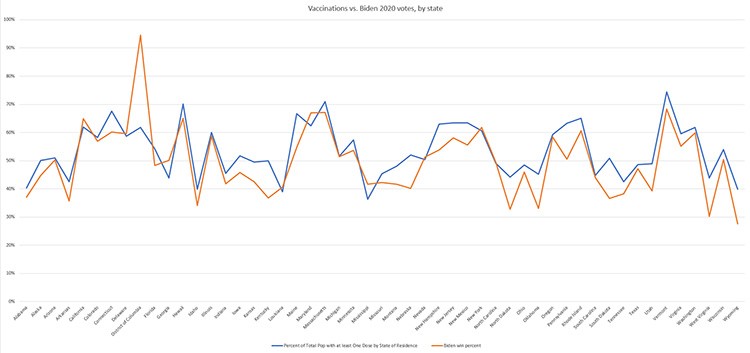
The trendlines of votes Biden officially received during the 2020 election closely align with the number of people inoculated. It looks like the only place where the president has a chance of being welcome to go on his get-the-vaccine crusade is his own neighborhood in Washington D.C., which gave him more than 90 percent of its votes, but only got a little over 60 percent of the residents inoculated.
The rest of the “vaccine hesitant” nation will more likely meet the effort with skepticism, at best. As Ronald Reagan once said, “The nine most terrifying words in the English language are, “I’m from the government, and I’m here to help.”

